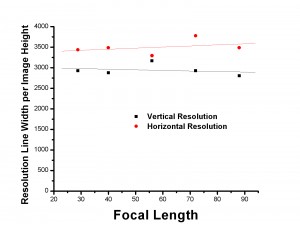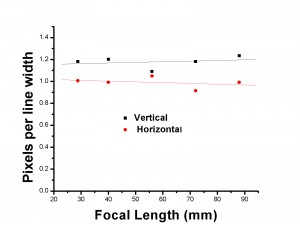
Figure 1 – horizontal and vertical resolution of the Canon S 18-55 lens on the T2i shown as line widths per image height as a function of focal length
In the second part of our exploration of how to measure camera resolution, I presented data which showed that for my Canon S 18-55 lens measured on my Canon T2i at 18 mm (actually 29 mm because of the 1.6 multiplier due to the size of the sensor element) the resolution was very close to the 3456 value for pixel limited resolution. This mean that this lens, using this criterion for sharpness, is performing about as best as it could.
So let’s call this an example of a good lens and ask how it performs over a series of focal lengths. That is we ask whether resolution is perserved as the lens is zoomed in. We perform the measurement as before only holding the f-number at 7.1 and progressively moving further and further away from the target. For each focal length we just fill the image as before.

Figure 2 – horizontal and vertical resolution of the Canon S 18-55 lens on the T2i shown as pixels per line width as a function of focal length
The results of such an experiment are shown in Figure 1, where we plot line widths per image height as a function of focal length. We observe a very flat response. In all cases the resolution is close to the pixel limites value of 3456.
In fact, it might be more userful to consider the graph of Figure 2, where I plot the pixels per line width as a function of focal length. For both horizontal and vertical resolution, this value is very close to the theoretical limit of 1.0.
Now that we have an example of good lens performance we are in a position to look at “bad lensed” and to examine how other factors and settings affect image resolution and sharpness.
